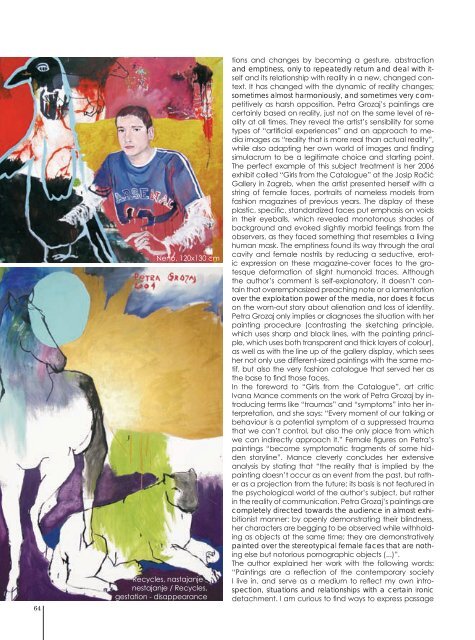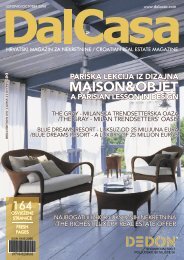at home with antonio fusco sve o grijanju - DalCasa
at home with antonio fusco sve o grijanju - DalCasa
at home with antonio fusco sve o grijanju - DalCasa
- No tags were found...
You also want an ePaper? Increase the reach of your titles
YUMPU automatically turns print PDFs into web optimized ePapers that Google loves.
64Neno, 120x130 cmRecycles, nastajanje -nestajanje / Recycles,gest<strong>at</strong>ion - disappearancetions and changes by becoming a gesture, abstractionand emptiness, only to repe<strong>at</strong>edly return and deal <strong>with</strong> itselfand its rel<strong>at</strong>ionship <strong>with</strong> reality in a new, changed context.It has changed <strong>with</strong> the dynamic of reality changes;sometimes almost harmoniously, and sometimes very competitivelyas harsh opposition. Petra Grozaj’s paintings arecertainly based on reality, just not on the same level of reality<strong>at</strong> all times. They reveal the artist’s sensibility for sometypes of “artificial experiences” and an approach to mediaimages as “reality th<strong>at</strong> is more real than actual reality”,while also adapting her own world of images and findingsimulacrum to be a legitim<strong>at</strong>e choice and starting point.The perfect example of this subject tre<strong>at</strong>ment is her 2006exhibit called “Girls from the C<strong>at</strong>alogue” <strong>at</strong> the Josip RačićGallery in Zagreb, when the artist presented herself <strong>with</strong> astring of female faces, portraits of nameless models fromfashion magazines of previous years. The display of theseplastic, specific, standardized faces put emphasis on voidsin their eyeballs, which revealed monotonous shades ofbackground and evoked slightly morbid feelings from theobservers, as they faced something th<strong>at</strong> resembles a livinghuman mask. The emptiness found its way through the oralcavity and female nostrils by reducing a seductive, eroticexpression on these magazine-cover faces to the grotesquedeform<strong>at</strong>ion of slight humanoid traces. Althoughthe author’s comment is self-explan<strong>at</strong>ory, it doesn’t containth<strong>at</strong> overemphasized preaching note or a lament<strong>at</strong>ionover the exploit<strong>at</strong>ion power of the media, nor does it focuson the worn-out story about alien<strong>at</strong>ion and loss of identity.Petra Grozaj only implies or diagnoses the situ<strong>at</strong>ion <strong>with</strong> herpainting procedure (contrasting the sketching principle,which uses sharp and black lines, <strong>with</strong> the painting principle,which uses both transparent and thick layers of colour),as well as <strong>with</strong> the line up of the gallery display, which seesher not only use different-sized paintings <strong>with</strong> the same motif,but also the very fashion c<strong>at</strong>alogue th<strong>at</strong> served her asthe base to find those faces.In the foreword to “Girls from the C<strong>at</strong>alogue”, art criticIvana Mance comments on the work of Petra Grozaj by introducingterms like “traumas” and “symptoms” into her interpret<strong>at</strong>ion,and she says: “Every moment of our talking orbehaviour is a potential symptom of a suppressed traum<strong>at</strong>h<strong>at</strong> we can’t control, but also the only place from whichwe can indirectly approach it.” Female figures on Petra’spaintings “become symptom<strong>at</strong>ic fragments of some hiddenstoryline”. Mance cleverly concludes her extensiveanalysis by st<strong>at</strong>ing th<strong>at</strong> “the reality th<strong>at</strong> is implied by thepainting doesn’t occur as an event from the past, but r<strong>at</strong>heras a projection from the future; its basis is not fe<strong>at</strong>ured inthe psychological world of the author’s subject, but r<strong>at</strong>herin the reality of communic<strong>at</strong>ion. Petra Grozaj’s paintings arecompletely directed towards the audience in almost exhibitionistmanner: by openly demonstr<strong>at</strong>ing their blindness,her characters are begging to be observed while <strong>with</strong>holdingas objects <strong>at</strong> the same time; they are demonstr<strong>at</strong>ivelypainted over the stereotypical female faces th<strong>at</strong> are nothingelse but notorious pornographic objects (...)”.The author explained her work <strong>with</strong> the following words:“Paintings are a reflection of the contemporary societyI live in, and serve as a medium to reflect my own introspection,situ<strong>at</strong>ions and rel<strong>at</strong>ionships <strong>with</strong> a certain ironicdetachment. I am curious to find ways to express passage
















